October 2012, I started my MFA studies at the Vermont College of Fine Arts. I know it will prove to be one of the most profound experiences of my life. I'll try to share some of my adventure on these pages with you.
semester 1 > pkt1, pkt2, pkt3, pkt4, pkt5
semester 2 <
semester 3 <
about me <
contact me
email ::: dtown65@earthlink.net
ph :::::: 816.682.4438
fb ::::::: facebook.com/dtown65
li :::::::: darlene.town

© Darlene Town - all images within this
site
property of myself and/or my clients.
the office project ::
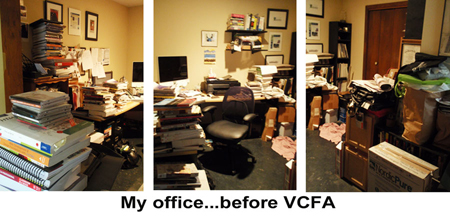
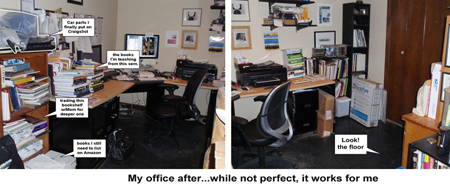

 reading: The Places That Scare You: A Guide to Fearlessness in Difficult Times - Pema Chödrön
reading: The Places That Scare You: A Guide to Fearlessness in Difficult Times - Pema Chödrön
:: excerpts I found interesting:
We can let the circumstances of our lives harden us so that we become increasingly resentful and afraid, or we can let them soften us and make us kinder and more open to what scares us. We always have this choice.
Bodhichitta:
- Chitta = "mind", "heart", or "attitude"
-
Bodhi = "awake", "enlightened", "completely open"
Bodhichitta also equated, in part, with compassion—our ability to feel the pain that we share with
others. Without realizing it we continually shield ourselves form this pain because it scares us. We
put up protective walls made of opinions, prejudices, and strategies, barriers that are built on a
deep fear of being hurt.
An analogy for bodhichitta is the rawness of a broken heart. Sometimes this broken heart gives
birth to anxiety and panic, sometimes to anger, resentment, and blame. But under the hardness
of that armor there is the tenderness of genuine sadness. This is our link with all those who have
ever loved. This genuine heart of sadness can teach us great compassion. It can humble us when
we're arrogant and soften us when we are unkind. It awakens us when we prefer to sleep and
pierces through our indifference. This continual ache of the heart is a blessing that when accepted
fully can be shared with all.
A human being is a part of the whole called by us "the universe," a part limited in time and space.
He experiences himself, his thoughts and feelings, as something separate from the rest—a kind
of optical delusion of consciousness. The delusion is a kind of prison for us, restricting us to our
personal desires and affection for a few persons nearest to us. Our task must be to free ourselves
from this prison by widening the circle of understanding and compassion to embrace all living
creatures and the whole of nature in its beauty. — Albert Einstein
The first of the three lords of materialism is called the lord of form. It represents how we look
to externals to give us solid ground. We can begin to pay attention to our methods of escape.
[Discusses the use of "shopping therapy", turning to food, drugs, sex, and other methods of
coping.]
The second of the three lords of materialism is the lord of speech. This lord represents how we use beliefs of all kinds to give us the illusion of certainty about the nature of reality.
Yeah, this is me. Sometimes I oversimplify and assume I fully understand the background of another person, or their motives, and form rigid opinions or make generalized statements. I often find myself retracting and apologizing. This is a genetic trait (I'm convinced) and everyone in my family does this. I'm probably less so than the rest of my family due to years of management training and exposure to so many types of people.The third lord, the lord of mind, uses the most subtle and seductive strategy of all. The lord of mind comes into play when we attempt to avoid uneasiness by seeking special states of mind.
I have friends who do this. It concerns me. I fear for their mental health. I don't think this applies to me personally. I am too open emotionally, to a fault sometimes when it comes to diplomacy and word crafting in my professional world. I can be too direct and open and some folks find this off putting. I'm fine with someone doing this with me. It helps me understand their position better without guessing what their real agenda is. I think this is carryover from my newspaper days. There was no time for politics.Everything is in process.
I love this statement! I must print this out and tape it to my monitor, next to my other mantra. I must remind myself of this every day. I know it to be true, but I have so little patience, I often forget it.That we take ourselves so seriously, that we are so absurdly important in our own minds, is a problem for us. We feel justified in denigrating ourselves or in feeling that we are more clever than other people. Self-importance hurts us, limiting us to the narrow world of our likes and dislikes. We end up bored to death with ourselves and our world. We end up never satisfied.
Crap! I could have stopped reading at this point. This defines a lot about me. How did I get this way? I didn't start out like this. I was the outside observer, listening to the definitions given by others.Somewhere it changed.
When we train in awakening bodhichitta, we are nurturing the flexibility of our mind. In the most
ordinary terms, egolessness is a flexible identity. It manifests as inquisitiveness, as adaptability, as
humor, as playfulness. It is our capacity to relax with not knowing, not figuring everything out,
with not being at all sure about who we are—
or who anyone else is either.
Because we mistakenly take what is always changing to be permanent, we suffer.
In repeating our quest for instant gratification, pursuing addictions of all kinds—some seemingly
benign, some obviously lethal—we continue to reinforce old patterns of suffering. We strengthen
dysfunctional patterns.
Maitri = the complete acceptance of ourselves as we are, a simple, direct relationship with the way we are.
This feels like someone giving me (and everyone else) permission to remain where we are and not seek improvement or further enlightenment. Maybe I read too much into it. Only when we relate with ourselves without moralizing, without harshness, without deception,
can we let go of harmful patterns. Without maitri, renunciation of old habits becomes abusive.
I don't fully grasp this, but feel that I should. The book said "this is an important point."
There are certain advanced techniques in which you intentionally churn up emotions by thinking
of people or situations that make you angry or lustful or afraid. The practice is to let the thoughts
go and connect directly with the energy, asking yourself, "Who am I without these thoughts?"
What we do with meditation practice is simpler than that, but I consider it equally daring. When emotional distress arises uninvited, we let the story line go and abide with the energy.
"Who am I without these thoughts?"Provocative concept.
The warrior = nurturing open-mindedness and courage
Pema doesn't watch the same movies I do where the warrior demonstrates more primal characteristics.
The 4 limitless qualities—loving-kindness, compassion, joy, and equanimity
There is but one person on this planet who will never receive loving-kindness from me. She will receive compassion from me and I'm working on the equanimity with her.Choosing to cultivate love rather than anger just might be what it takes to save the planet from extinction.
OK. You've got my attention.We wish not only that the outer manifestations of suffering will decrease but also that all of us could stop acting and thinking in ways that escalate ignorance and confusion.
Can I have an "Amen!" The best way to serve ourselves is to love and care for others. These are powerful tools for
dissolving the barriers that perpetuate not just our own unhappiness, but the suffering of all
beings.
Rejoicing in ordinary things is not sentimental or trite. It actually takes guts. Each time we drop
our complaints and allow everyday good fortune to inspire us, we enter the warrior's world. We
can do this even at the most difficult moments. Everything we see, hear, taste, and smell has the
power to strengthen and uplift us. As Longchenpa says, the quality of joy is like finding cool,
refreshing shade.
When we encounter any pleasure or tenderness in our life, we cherish that and rejoice. Then we
make the wish that others could also experience this delight or this relief. In a nutshell, when
life is pleasant, think of others. When life is a burden, think of others. If this is the only training
we ever remember to do, it will benefit us tremendously and everyone else as well. It's a way of
bringing whatever we encounter onto the path of awakening bodhichitta.
It's easy to continue, even after years of practice, to harden into a position of anger and indignation. However, if we can contact the vulnerability and rawness of resentment or rage or whatever it is, a bigger perspective can emerge. In the moment that we choose to abide with the energy instead of acting it out or repressing it, we are training in equanimity, in thinking bigger than right and wrong. This is how all the four limitless qualities evolve from limited to limitless: we practice catching our mind hardening into fixed views and do our best to soften. Through softening, the barriers come down.
I obviously need to practice this more.With unfailing kindness, your life always presents you what you need to learn. Whether you stay home or work in an office or what ever, the next teacher is going to pop right up. —Charlotte Joko Beck
This I completely believe. I also believe the universe provides you whatever you need when you need it. (Not to be confused with when you want it.)When we identify ourselves as the helper, it means we see others as helpless.
Wow. I wonder if I do this. No, I don't go out of my way to help people just because I think they need it (except if someone is about to drop something or get hit by a car). I wait for it to be asked for. But I do think there are a lot of helpless folks floating around.
Idiot compassion: This is when we avoid conflict and protect our good image by being kind when we should say a definite "no." Compassion doesn't imply only trying to be good.
Haha! She said "idiot compassion"!Ask my students. I have no problem saying "no" when it is in their best interest, even if they don't agree with me at the time.
If we wish to alleviate injustice and suffering, we have to do it with an unprejudiced mind.
Laziness: The first kind of laziness, comfort orientation, is based on our tendency to avoid inconvenience...In this way we lose touch with the texture of life. We trust the quick "upper" and become accustomed to automatic results. This particular brand of laziness can make us aggressive. We become outraged at inconvenience.
Outraged is such a strong word. Few of us are satisfied with retreating from the world and just working on ourselves. We want our
training to manifest and to be of benefit. The bodhisattva-warrior, therefore, makes a vow to wake
up not just for himself but for the welfare of all beings.
6 traditional activities of bodhisattva compassionate living training (aka 6 paramitas):
- generosity, discipline, patience, enthusiasm, meditation, and prajna (unconditional wisdom)
[Being comfortable with uncertainty]
We get into a raft on this shore, where we're struggling with notions of right and wrong, busy
solidifying the illusion of ground by constantly seeking predictability. And we're traveling across
the river to the other side, where we are liberated from the narrow-mindedness and dualistic
thinking that characterize ego-clinging.
The essence of generosity is letting go. Pain is always a sign that we are holding on to something—
usually ourselves. When we feel unhappy, when we feel inadequate, we get stingy; we hold on
tight.
Prajna = seeing things without "shoulds" or "should nots."
When we practice discipline with flexibility, we become less moralistic and more tolerant.
Six activities of the bodhisattva warrior:
- Generosity—giving as a path of learning to let go
- Discipline—training in not causing harm in a way that is daring and inflexible
- Patience—training in abiding with the restlessness of our energy and letting things evolve at
their own speed
- Joyful enthusiasm—letting go of our perfectionism and connecting with the living quality of
every moment
- Meditation—training in coming back to being right here with gentleness and precision
- Prajna—cultivating an open, inquiring mind
With these six activities of the bodhisattva, we learn ow to travel to the other shore, and we do our best to take everyone we can find along with us.
OM GATE GATE PARAGATE PARASAMGATE BODHI SVAHA
- this mantra contains the entire teachings of abiding in prajnaparamita, abiding in the fearless
state
We might assume that as we train in bodhichitta, our habitual patterns will start to unwind—that
day by day, month by month, we'll be more open-minded, more flexible, more of a warrior. But
what actually happens with ongoing practice is that our patterns intensify. In vajrayana Buddhism
this is called "heightened neurosis." It's not something we do on purpose. It just happens. We
catch the scent of groundlessness, and despite our wishes to remain steady, open, and flexible, we
hold on tightly in very habitual ways.
The most straightforward advice on awakening bodhichitta is this:
practice not causing harm to anyone—yourself or others—and every day, do what you can to be
helpful.
To do this:
1. not setting up the target for the arrow,
2. connecting with the heart,
3. seeing obstacles as teachers, and
4. regarding all that occurs as a dream.
Actually, a lunatic is far less crazy than a sane person who harms us, for that so-called sane person
has the potential to realize in acting aggressively he is sowing seeds of his own confusion and
dissatisfaction. His present aggression is strengthening future, more-intense habits of aggression.
He is creating his own soap opera. This kind of life is painful and lonely. The one who harms us is
under the influence of patterns that could continue to produce suffering forever.
By not knowing, not hoping to know, and not acting like we know what's happening, we begin to
access our inner strength. Yet it seems reasonable to want some kind of relief. If we can make the
situation right or wrong, if we can pin it down in any way, then we are on familiar ground. But
something has shaken up our habitual patterns and frequently they no longer work. Staying with
volatile energy gradually becomes more comfortable than acting it out or repressing it. This openended
tender place is called bodhichitta. Staying with it is what heals. It allows us to let go of our
self-importance. It's how the warrior learns to love.
The in-between state—where moment by moment the warrior finds himself learning to let go—is
the perfect training ground. It really doesn't matter if we feel depressed about that or inspired.
There is absolutely no way to do this just right. That's why compassion and maitri, along with
courage, are vital: they give us the resources to be genuine about where we are, but at the same
time to know that we are always in transition, that the only time is now, and that the future is
completely unpredictable and open.
As we continue to train, we evolve beyond the little me who continually seeks zones of comfort.
We gradually discover that we are big enough to hold something that is neither lie nor truth,
neither pure nor impure, neither bad nor good. But first we have to appreciate the richness of the
groundless state and hang in there.
This is a big one and I want to continue to keep working on this idea of letting go and being comfortable with being groundless.
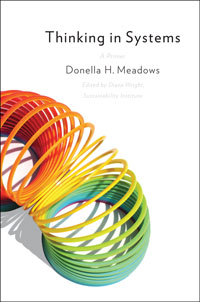 reading: Thinking in Systems : A Primer- Donella H. Meadows (editied by Diana Wright)
reading: Thinking in Systems : A Primer- Donella H. Meadows (editied by Diana Wright)
:: excerpts I found interesting:
So what is a system: A system is a set of things—people, cells, molecules, or whatever—interconnected in such a way that they produce their own pattern of behavior over time.
Political leaders don't cause recessions or economic booms. Ups and downs are inherent in the structure of the market economy.
- Competitors rarely cause a company to lose market share. They may be there to scoop up the advantage, but the losing company creates its losses at least in part through its own business practices.
- The oil-exporting nations are not solely responsible for oil-price rises. Their actions alone could not trigger global price rises and economic chaos if the oil consumption, pricing, and investment policies of the oil-importing nations had not built economies that are vulnerable to supply interruptions.
- The flu virus does not attack you; you set up the conditions for it to flourish within you.
- Drug addiction is not the failing of an individual and no one person, no matter how tough,
no matter how loving, can cure a drug addict—not even the addict. It is only through
understanding addiction as part of a larger set of influences and societal issues that one can begin to address it.
Because of feedback delays within complex systems, by the time the problem becomes apparent it
may be unnecessarily difficult to solve.
— A stitch in time saves nine.
According to the competitive exclusion principle, if a reinforcing feedback loop rewards the
winner of a competition with the means to win further competitions, the result will be the
elimination of all but a few competitors.
—For he that hath, to him shall be given; and he that hath not, from him shall be taken even that
which he hath (Mark 4:25)
or
—The rich get richer and the poor get poorer
It's easy to point to external factors (vs. internal) for cause and blame.
The behavior of a system cannot be known by just knowing the elements of which the system is made.
Look Beyond the Players to the Rules of the Game
You think that because you understand "one" that you must therefore understand "two" because
one and one make two. But you forget that you must also understand "and." —Sufi teaching story
A system can change elements but still behave the same (i.e., a football team can get new players, but it's still football).
Stock = the memory of the history of changing flows within the system
A stock takes time to change because flows take time to flow.

Systems thinkers see the world as a collection of stocks along with the mechanisms for regulating
the levels in the stocks by manipulating flows. They see the world as a collection of "feedback
processes."
A feedback loop is a closed chain of causal connections from a stock, through a set of decisions
or rules or physical laws or actions that are dependent on the level of the stock, and back again
through a flow to change the stock.
Balancing feedback loops are equilibrating or goal-seeking structures in systems and are both
sources of stability and sources of resistance to change (i.e., ice tea or hot tea balancing to zero
discrepancy = room temperature).
Reinforcing loops are found wherever a system element has the ability to reproduce itself or to grow as a constant fraction of itself. Those elements include populations and economies.
This stuff is fascinating to think about. I've barely cracked the book. Finished chapter one: Systems Basics. The closing of this chapter was good:...continued in Packet #2
art making:
:: looking at Self-Organizing Systems (at my house)
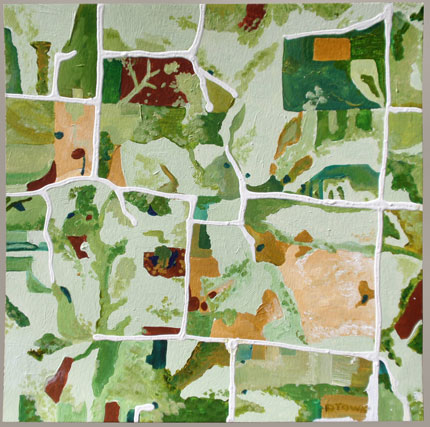
Acrylic on 185# paper - an aerial view of my neighborhood - about a 2 mile radius;
I took liberties with colors. The lighter greens are the forested and highest elevations.
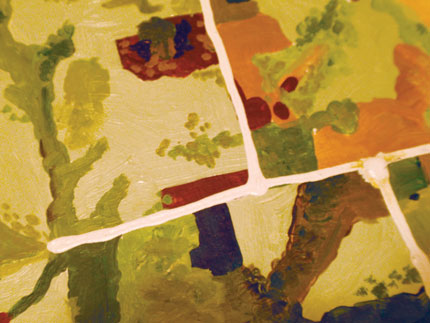
zoomed in (sorry, bad lighting)
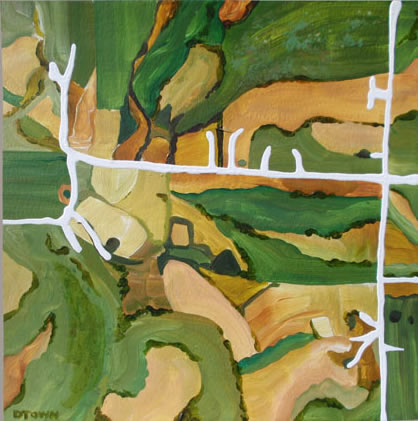
A closer aerial view of my neighborhood - about 1 mile radius;
I was able to work with larger shapes and this allows me to push the pigment around more and use some glazing.
Two follow up images are submitted with packet 2.
Below are 3 studies with a meditation phrase I re-discovered thorugh my office-cleaning:
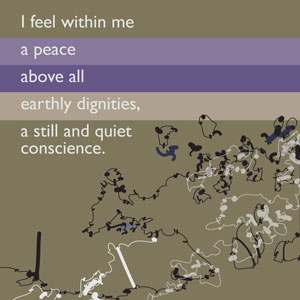


^ top

